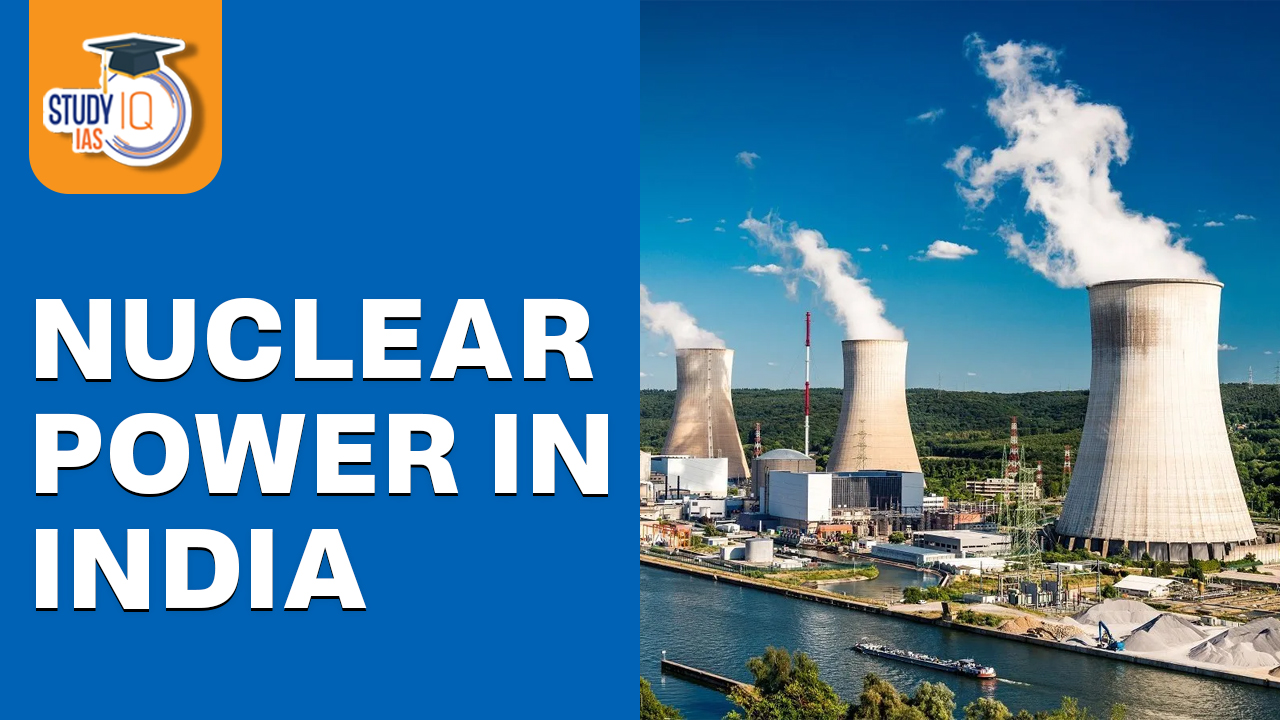Table of Contents
Context: The first largest indigenous 700 MWe Kakrapar Nuclear Power Plant Unit-3 in Gujarat starts operations at full capacity.
Nuclear Power in India
Nuclear power in India is a major source of electricity, accounting for about 9% of the country’s total generation. India has 22 nuclear power reactors in operation, with a total capacity of over 6,700 megawatts. Nuclear power is a reliable source of electricity, and it can help to reduce India’s reliance on fossil fuels. It is a clean source of energy, and it does not produce greenhouse gases.
India’s nuclear program began in the early 1950s, and the country’s first nuclear power reactor, the Tarapur Atomic Power Station, was commissioned in 1969. India has since become a major nuclear power producer, and its nuclear program is now one of the largest in the developing world.
The Indian government has ambitious plans to expand its nuclear power program in the coming years. The government has set a target of generating 25% of the country’s electricity from nuclear power by 2050. To achieve this target, India is planning to build up to 100 new nuclear power reactors over the next few decades.
What is Nuclear Energy?
Nuclear energy is a type of energy that is generated by the process of nuclear reactions- either nuclear fission or nuclear fusion. The energy released during these reactions can be harnessed and used to produce electricity, heat, or other forms of energy.
Nuclear Fission
It is a process in which the nucleus of an atom is split into two or more smaller nuclei, releasing a large amount of energy in the process. This process is used in nuclear power plants to generate electricity. One example of nuclear fission is the reaction that occurs in a nuclear reactor when uranium atoms are split into smaller atoms.
Nuclear Fusion
It is a process in which two or more atomic nuclei come together to form a single, more massive nucleus, releasing a large amount of energy in the process. This process occurs naturally in stars, including our own sun. One example of nuclear fusion is the reaction that occurs in a hydrogen bomb.
Nuclear Enrichment
- Natural uranium consists of two different isotopes – nearly 99% U-238 and only around 0.7% of U-235.
- U-235 is a fissile material that can sustain a chain reaction in a nuclear reactor.
- The enrichment process increases the proportion of U-235 through the process of isotope separation (U-238 is separated from U-235).
- For nuclear weapons, enrichment is required up to 90% or more which is known as weapons-grade uranium.
- Low-enriched uranium, which typically has a 3-5% concentration of U-235, can be used to produce fuel for commercial nuclear power plants.
- Highly enriched uranium has a purity of 20% or more and is used in research reactors.

Methods for Uranium Enrichment
- The most common method of enrichment is through the use of centrifuges, which spin at high speeds to create a centrifugal force that separates the isotopes based on their weight.
- Another method is gaseous diffusion, where uranium hexafluoride gas is forced through a series of barriers, allowing the lighter U-235 to diffuse more rapidly and become more concentrated.
Significance of Nuclear Energy
- Low carbon emissions: Nuclear energy is a low-carbon source of power that does not release greenhouse gases into the atmosphere, unlike fossil fuels.
- Reliability: Nuclear power plants can run for long periods of time without interruption and are highly reliable sources of electricity.
- High energy density: Nuclear fuel contains a high energy density, meaning that it can produce a large amount of energy from a small amount of fuel.
- Independence from fossil fuels: Nuclear power does not depend on fossil fuels, which are finite resources subject to price fluctuations and environmental pollution.
- Base load power: Nuclear power can provide reliable baseload power to complement intermittent renewable energy sources like wind and solar power.
- Energy security: Nuclear power can help to increase energy security by reducing reliance on foreign sources of oil and gas.
- Advanced technologies: Nuclear power research and development have led to advances in technologies like medical imaging, food irradiation, and space exploration.
Concerns Associated with Nuclear Energy
- Nuclear accidents: Nuclear accidents can have catastrophic consequences, as seen in Chornobyl and Fukushima.
- Radioactive waste: Nuclear power plants produce radioactive waste that remains dangerous for thousands of years and must be carefully stored to prevent contamination.
- The Fukushima disaster in 2011 resulted in a significant release of radioactive materials into the environment. These materials (nuclear waste), can remain radioactive and dangerous for thousands of years.
- Limited Domestic Resources: India has limited domestic resources of uranium, which is the fuel for nuclear reactors.
- This has forced the country to import a significant portion of its uranium requirements, making the country’s nuclear energy program vulnerable to global market conditions and political tensions.
- Proliferation risk: The technology and materials used in nuclear power plants can be used to make nuclear weapons, making nuclear power a proliferation risk.
- High cost: Nuclear power plants are expensive to build and maintain, and the high costs can make it difficult for countries to justify building new plants.
- Security risks: Nuclear power plants and nuclear waste storage facilities can be targets for terrorism or other security threats.
- Decommissioning challenges: Decommissioning nuclear power plants at the end of their useful life is a complex and costly process that can take decades to complete.
- International Sanctions: India is not a member of the Nuclear Non-Proliferation Treaty (NPT) and has faced international sanctions in the past for its nuclear weapons program.
- This has limited its access to advanced nuclear technology and fuel supplies from other countries.
- Public opposition: Nuclear energy is a polarizing issue that can generate significant public opposition due to concerns about safety and waste storage.
India’s Nuclear Energy Progress and Potential
- Nuclear energy currently accounts for around 3% of India’s total electricity generation.
- India has over 22 nuclear reactors in 7 power plants across the country which produces 6780 MW of nuclear power.
- Also, the government plans to commission 20 more nuclear power plants by 2031 and will add nearly 15,000 MW to power generating capacity.
- Today, India is the sixth largest in the world in the number of functional reactors and the second largest in the total number of reactors including those under construction.
- India has significant reserves of thorium, a naturally occurring radioactive element that can be used as a fuel in nuclear reactors.
- With the world’s largest reserves of thorium, estimated at around 360,000 tonnes, India has the potential to become a major player in the nuclear energy sector.
- In addition to thorium, India also has significant reserves of uranium (70,000 tonnes), which can be used as fuel in nuclear reactors.

India’s Three-Stage Nuclear Power Programme
- India’s three-stage nuclear power programme was formulated by Homi Bhabha in the 1950s to secure the country’s long term energy independence, through the use of uranium and thorium reserves found in the monazite sands of coastal regions of South India.
- The ultimate focus of the programme is on enabling the thorium reserves of India to be utilized in meeting the country’s energy requirements.
| Stage | Details |
| Stage I – Pressurized Heavy Water Reactor [PHWR] |
|
| Stage II – Fast Breeder Reactor (FBR) |
|
| Stage III – Thorium Based Breeder Reactors |
|
Recent Developments in India’s Nuclear Landscape
- Joint Ventures with Public Sector Undertakings (PSUs): Government has also allowed Joint Ventures with PSUs to enhance India’s nuclear program.
- As a result, the Nuclear Power Corporation of India Limited (NPCIL) is now in two joint ventures with the National Thermal Power Corporation Limited (NTPC) and the Indian Oil Corporation Limited (IOCL).
- Diversifying the geographical spread: In the past, India’s nuclear installations were mostly located in South India or in Maharashtra and Gujarat in the west. However, the government is now promoting its expansion to other parts of the country.
- As an example, the upcoming nuclear power plant in Gorakhpur town of Haryana, which will become operational in the near future.
- Indigenization: The world’s first thorium-based nuclear plant, “Bhavni,” using Uranium-233, is being set up at Kalpakkam in Tamil Nadu. This plant will be entirely indigenous and will be the first of its kind. The experimental thorium plant “Kamini” already exists in Kalpakkam.


 Agricultural Monitoring and Event Detect...
Agricultural Monitoring and Event Detect...
 Genetically Modified Crops in India, Reg...
Genetically Modified Crops in India, Reg...
 What are Polycyclic Aromatic Hydrocarbon...
What are Polycyclic Aromatic Hydrocarbon...





















